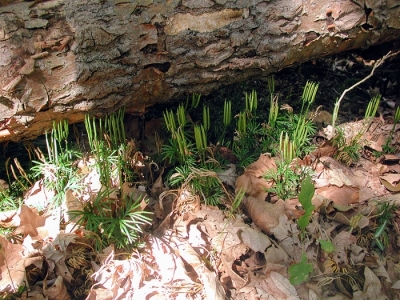WHEN DID PLANTS START TO GROW ON LAND?

|
The first land plants appeared during the Silurian period, around 440 million years ago. These simple plants reproduced by releasing spores. Plants produced oxygen and provided food for the first land animals - amphibians. Amphibians first developed in the Devonian period, 420 million years ago, from fish whose fins evolved into limbs. |
Botanists now believe that plants evolved from the algae; the development of the plant kingdom may have resulted from evolutionary changes that occurred when photosynthetic multicellular organisms invaded the continents. The earliest fossil evidence for land plants consists of isolated spores, tracheid-like tubes, and sheets of cells found in Ordovician rocks. The abundance and diversity of these fossils increase into the Silurian Period (about 443.8 million to 419.2 million years ago), where the first macroscopic (megafossil) evidence for land plants has been found. These megafossils consist of slender forking axes that are only a few centimetres long. Some of the axes terminate in sporangia that bear trilete spores (i.e., spores that divide meiotically to form a tetrad). Because a trilete mark indicates that the spores are the product of meiosis, the fertile axes may be interpreted as the sporophyte phase of the life cycle.
Fossils of this type could represent either vascular plants or bryophytes. Another possibility is that they are neither but include ancestors of vascular plants, bryophytes, or both. The earliest fossils also include at least one or more additional plant groups that became extinct early in the colonization of the land and therefore have no living descendants. By the early Devonian Period (about 419.2 million to 393.3 million years ago), some of the fossils that consist of forking axes with terminal sporangia also produced a central strand of tracheids, the specialized water-conducting cells of the xylem. Tracheids are a diagnostic feature of vascular plants and are the basis for the division name, Tracheophyta.
Credit: Britannica
Picture credit: Google